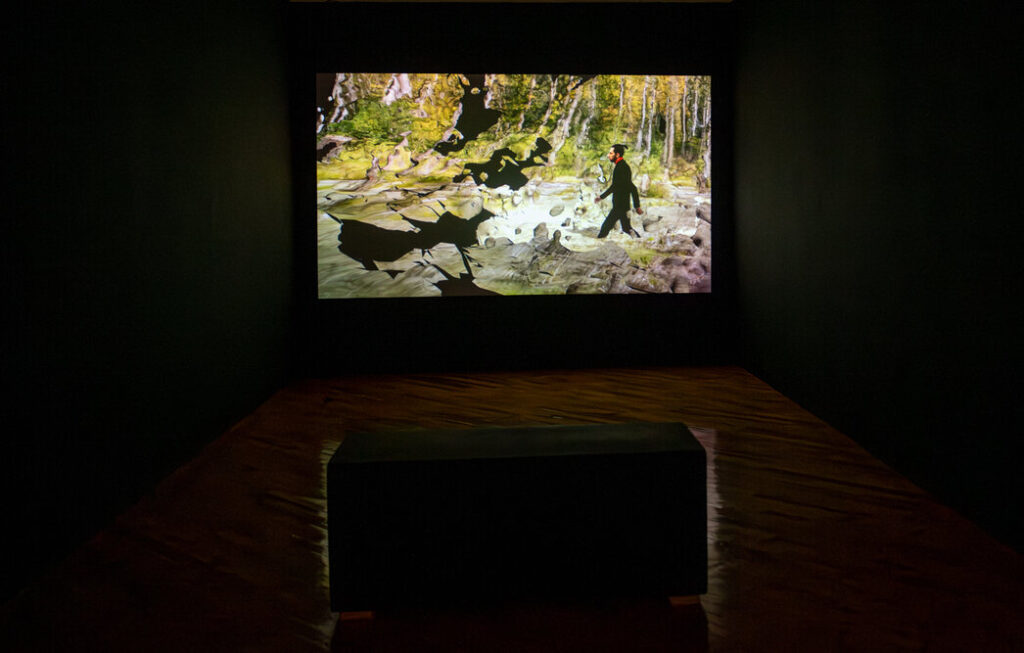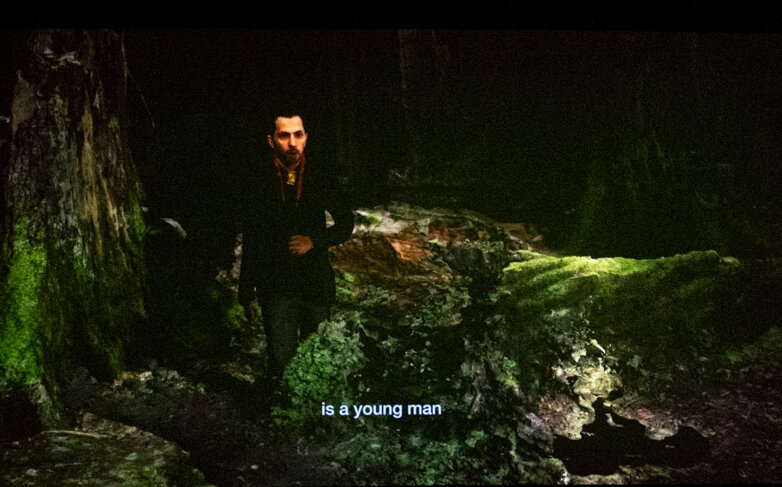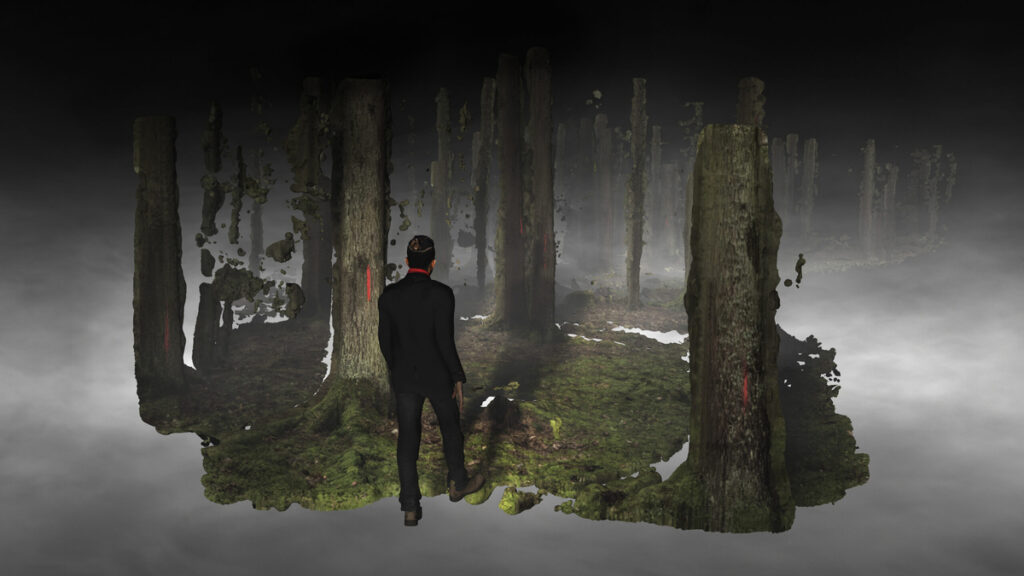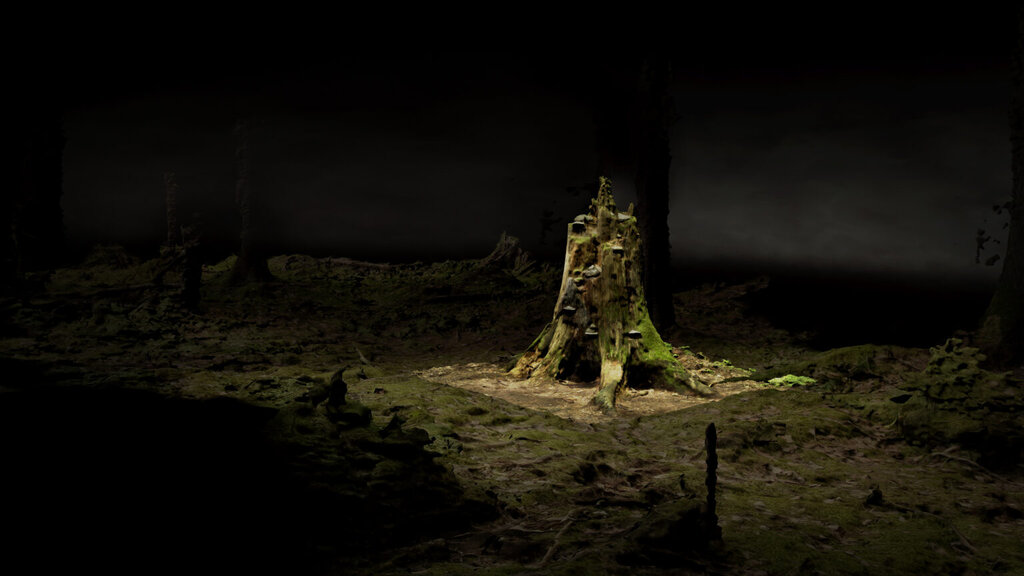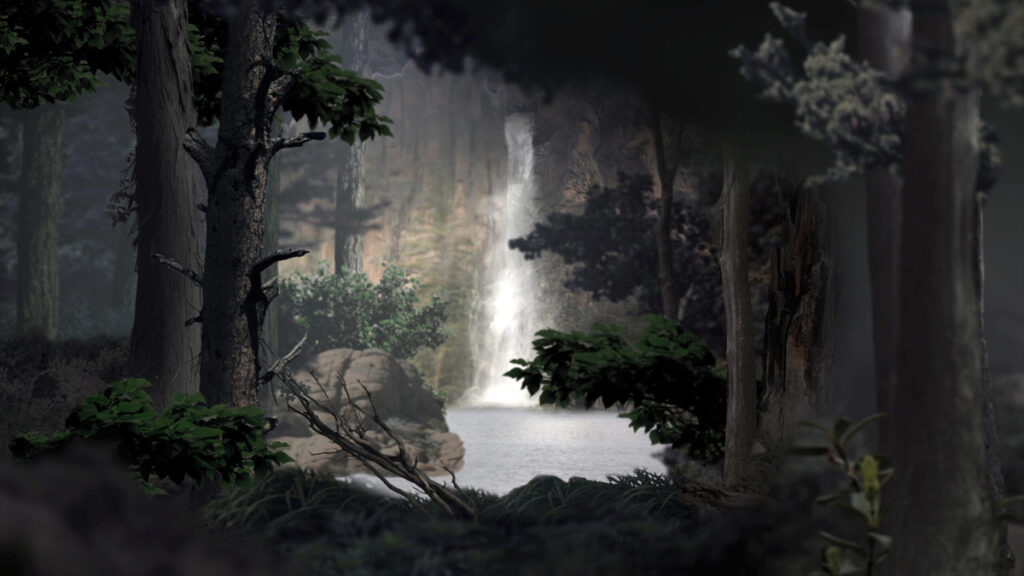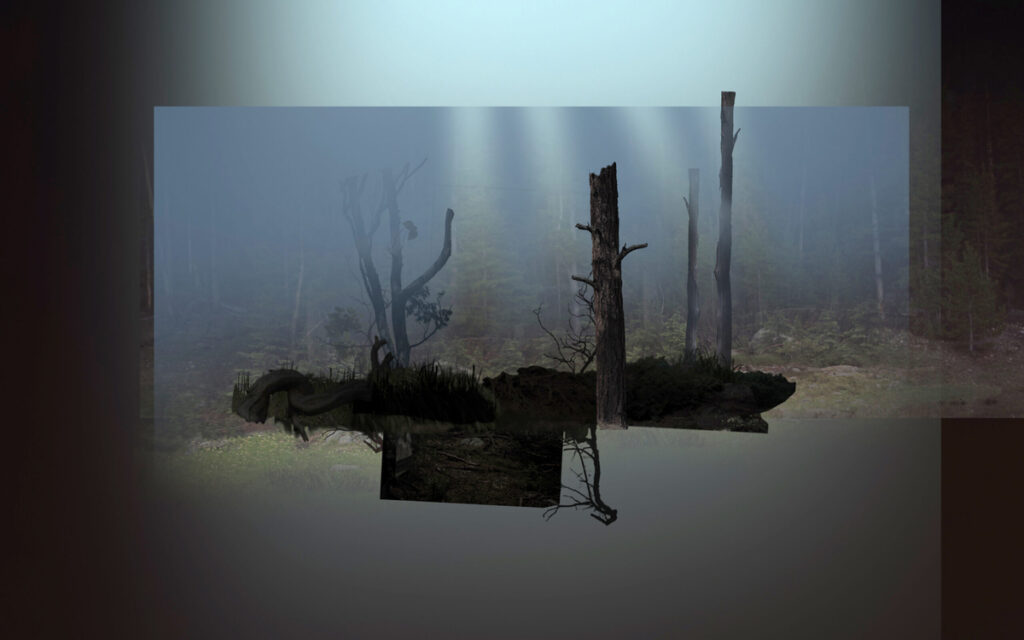In the Forest with Persijn Broersen and Margit Lukács
A Space Gallery is showing two video installations under the title Man is in the Forest, by the duo Persijn Broersen and Margit Lukács from the Netherlands. The videos, each about twelve minutes in length, are themselves titled Forest in Location (2018) and Mastering Bambi (2010). They are played simultaneously in abutting rooms. As a result, however, the soundtracks of the videos interfere with one another slightly. Although the effect, in an odd way, is to enhance the viewing of each.
In the accompanying literature for the show it is stated that both videos ‘take nature as their subject matter and work to unhinge hegemonic ways of looking at landscape’. I guess this is to say that the artists encourage the viewer to question, or reflect on, the dominant views of natural landscapes. Both videos feature the forest.
Installation view of Persijn Broersen and Margit Lukács, Forest on Location, 2018 (HD Video and Sound, 11:45 minutes). Photo: Selina Whittaker. Courtesy of A Space Gallery, Toronto
In Forest on Location they have created a pared down, dark simulacrum of a forest modelled on photographs from the famous Białowieża forest that spans Poland and Belarus. It features a ghostly avatar of Iranian opera singer Shahram Yazdani passing through fragments of trees, soil and rock, while singing a haunting version of ‘Nature Boy’ in Farsi – a song made famous by Nat King Cole in 1948. In Mastering Bambi Broersen and Lukács use similar digital technology to create an eerie version of scenes from the Disney animated film Bambi (1942). Its eeriness derives from the absence of any fauna in the forest, in contrast to the original Bambi film which features countless cute animals bounding through the woods.
Persijn Broersen and Margit Lukács, Forest on Location, 2018 (HD Video and Sound, 11:45 minutes). Photo: Selina Whittaker. Courtesy of A Space Gallery, Toronto
Both videos depict a forest landscape that is dark and brooding in atmosphere. One might describe it as enchanted or magical, but with a sinister edge. As noted, this characterization of forests has a long tradition, made famous by the fairytales of the brothers Grimm, e.g., the children Hansel and Gretel abandoned in the forest, and held captive there by an evil witch. Białowieża is one of the last patches of primeval forest in Europe that inspired such stories.
Persijn Broersen & Margit Lukács, Forest on Location, 2018 (HD Video and Sound, 11:45 mins). Courtesy of the artists and AKINCI, Amsterdam
Noted as well, in curator Vicky Maufawad-Paul’s accompanying essay, is how Broersen and Lukacs chose Disney’s Bambi and the Białowieża forest because they are two key cultural references that constitute our understanding of the ecosystem. But these cultural references also happen to share a deep connection to the tragic history of Europe, especially with respect to the Jews. And it is these connections that strike me as more pertinent vis-à-vis the contents of the videos.
Until the mid-nineteenth century Białowieża was a part of what was known as the Pale, namely the western edges of the Russian empire to where Jewish settlement was restricted. Later this territory would become the scene of the pogroms – the murder or expulsion of many thousands of Jews. The composer of the Yiddish song ‘Shvayg mayn Harts’ (Hush My Heart), Herman Yablokoff, on which the tune and theme of Eden Ahbez’s song ‘Nature Boy’ is based, emigrated from this region of Belarus and Poland to the United States to escape persecution. His song tells the story of a young man – ‘as lonely as a stone’ – wandering around Russia before settling in the US, but who never overcomes the persecution suffered in his youth. It clearly has an autobiographical element to it.
Persijn Broersen & Margit Lukács, Forest on Location, 2018 (HD Video and Sound, 11:45 mins). Courtesy of the artists and AKINCI, Amsterdam
Coincidentally the person who wrote the original story of Bambi, Bambi: The Story of a Life in the Forest (Bambi, eine Lebensgeschichte aus dem Wald), on which the Disney film is based, Felix Salten, was also a Jew who sought a better life with the background of persecution. And this story too is about loneliness in the face of a persecutory world (see Jack Zipe’s recent translation, The Original Bambi, Princeton Univ. Press). Salten chose, instead of emigrating, to pursue a career of writing in his hometown of Vienna by unmarking himself as Jewish that involved changing his name and attempting to integrate into non-Jewish Viennese society in the early twentieth century.
Persijn Broersen & Margit Lukács, Mastering Bambi, 2010 (HD Video and Sound, 12:30 mins). Courtesy of the artists and AKINCI, Amsterdam
Salten had a successful career as a journalist and writer. He began to spend his summers on the edge of a forest. He developed a keen interest in the animals there, and strangely enough identified with them in an important sense. More exactly, he saw the animals as helpless in the face of the arbitrary violence inflicted on them by local hunters. Their situation was not unlike his own as a Jew. Thus the story of Bambi can be understood as parallel to his own life story. In this original story Bambi does not settle down with the doe Faline and ‘have children’ – as the Disney version of the story has it – but instead, to aid his survival, he leaves her to lead a lonely life.
Persijn Broersen & Margit Lukács, Mastering Bambi, 2010 (HD Video and Sound, 12:30 mins). Courtesy of the artists and AKINCI, Amsterdam
I think this common theme of loneliness and persecution is amply reflected in the sombre and melancholic mood of Broersen and Lukács’s videos. The artists, we are told, remind us that the current climate crisis highlights the urgency in exposing people’s fantasies about nature. But what they do in focussing on these two references is also highlight our cruelty to one another. Indeed, recently the Białowieża forest was the very place where thousands of desperate refugees ended up trapped on the Polish border, some of whom died of exposure.
Hugh Alcock
*Exhibition information: Persijn Broersen and Margit Lukács, Man is in the Forest, May 5 – July 15, 2023, A Space Gallery, 401 Richmond St. W., suite 110, Toronto. Gallery hours: Tue – Fri 11am – 5pm, Sat 12 – 5pm.

